Culatello - the king, or the queen, of cured meats, traditionally made from pigs born and raised in Central-Northern Italy. Culatello is like prosciutto only... better... more flavor, better texture and much easier to make at home. It's made of the best part of a pig's leg. It's also the bigger and better brother of fiocco. Don't get me wrong, both are fantastic and very comparable pieces of meat that every charcuterie board would be happy or lucky to have, but culatello has a definite edge. I think it gets that edge from longer maturation where it develops more complex, refined flavors and noticeably improved texture.
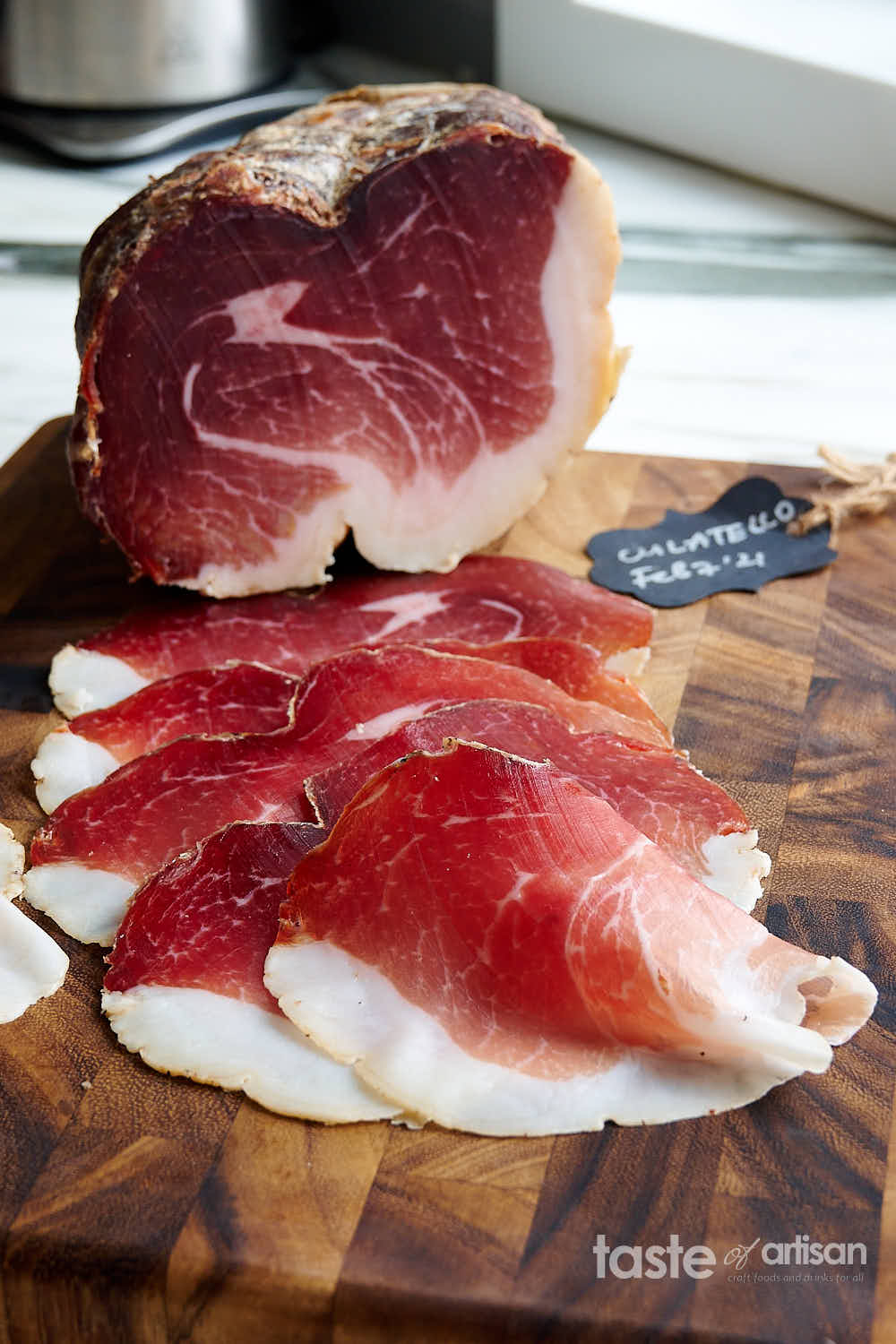
PROCESSING MEAT FOR CULATELLO
You start with a pig leg. Ideally, you want a leg from a mature pig, 2-3 years old, weighing at least 30o lbs. Preferably from a heritage pig raised on a pasture and fed varied natural foods. Look for local pig farms around where you live and see if you can source one from them. That's what I've done. If you can't find one of those, use what you can buy locally. I am sure you will still love the results.
Back in the day, I used to buy, and still sometimes do, all my meat for curing from a local grocery store. I once saw, though an open door to the back, a whole bunch of pig carcasses being butchered on big tables. So I struck a conversation with the man at the meat counter and learned that they'd get whole pigs every Thursday morning, butcher, and pack the meat that would be sold all week until they get a new delivery. So, there... every time I'd need nice, fresh meat, I'd go there on a Thursday morning and ask for a piece of whatever cut I needed. Always fresh, smelling very nice, beautiful color, great for curing.
Once the leg has been deboned, you remove the Culatello part and trim it to give it its characteristic rounded shape.
Here is a good video that shows how the leg is deboned and the Culatello and Fiocco pieces are prepared. I used it as a guide and it helped me a lot.
In a way, it’s similar to preparing meat for making Speck.
CURING AND DRYING
Once the meat is trimmed, it’s tied and salt-cured for 14 days, followed by stuffing it into a pig bladder and tying it with natural twine (now, this will take some time). I used a salted veil instead as it’s more readily available for me. It works just as well.
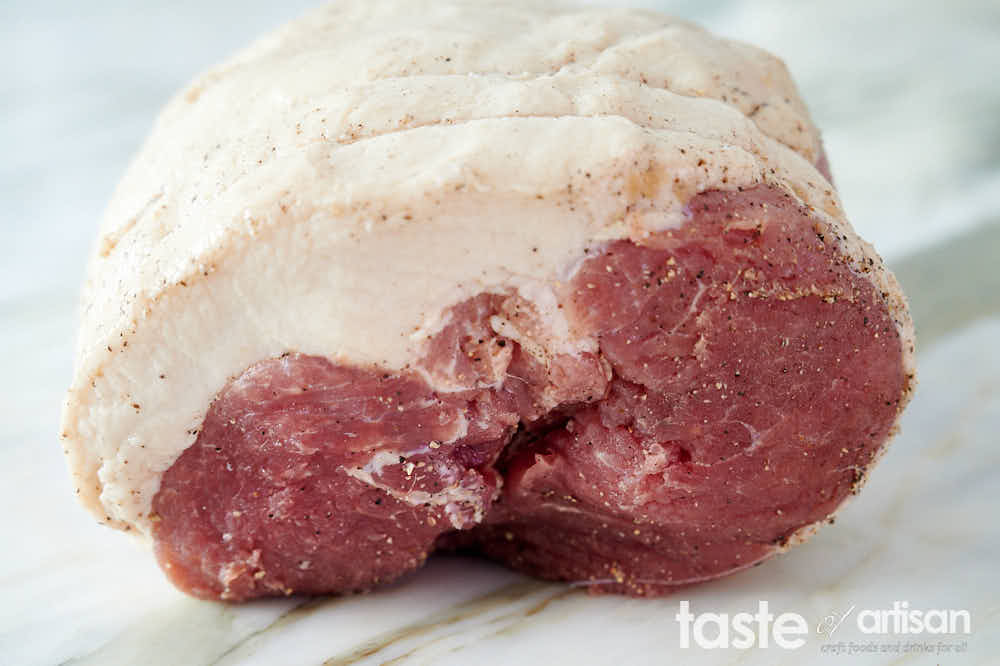
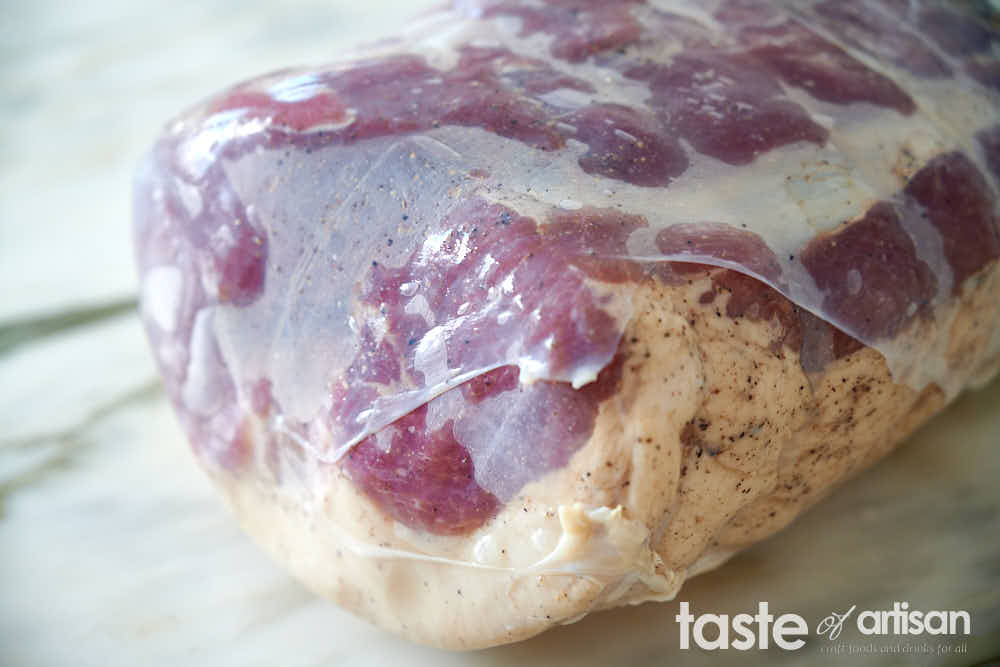

After curing, culatello typically undergoes a week of drying, during which the meat releases a lot of water. After that, culatello is ready for maturing. For reference, Culatello di Zibello requires about 10-14 months of maturing time. Maturing can take place in natural conditions, such as in the ancient cellars of the Lower Parma area, or in special environments, like a curing fridge, with controlled temperature and humidity.
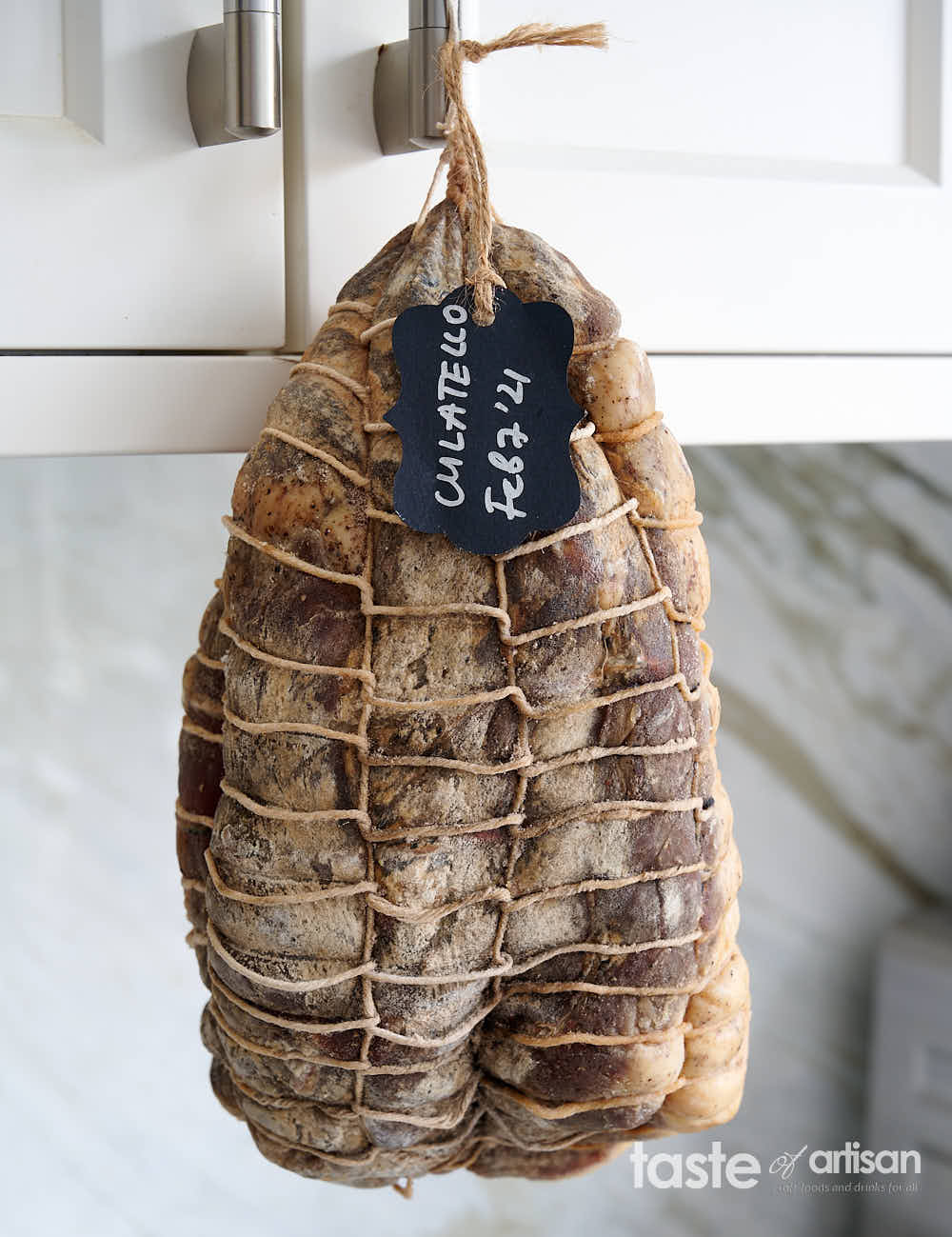
HOW TO CUT AND ENJOY CULATELLO
I wrote about the 'proper' etiquette for culatello and fiocco preparation for eating in the fiocco post. Let me repeat: no, you don’t just remove the casing and the twine, and then slice it.
No. You first remove the outer twine and wash the meat under cold running water to remove mold, then let it dry. Once dried, the meat needs to be softened. To soften it, you would soak it for two to three days in dry white or red wine. Only then you can proceed with the cutting. First, remove the casing and the twine (the one under the casing) from the part you want to consume. Then slice it very thinly and enjoy.
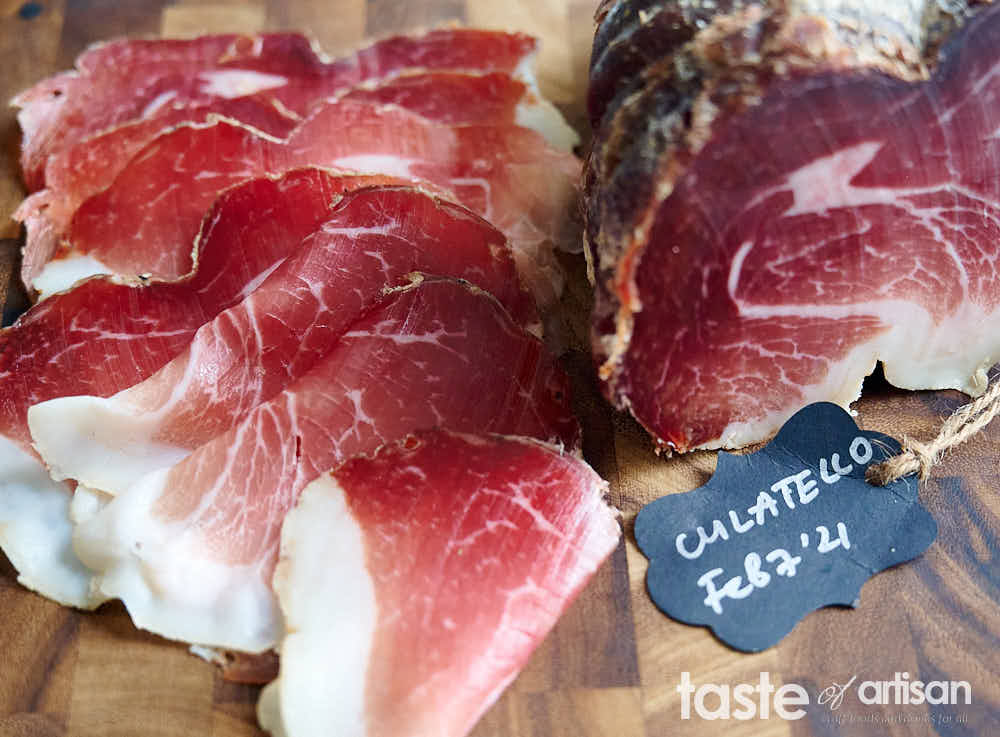
STORING CULATELLO
To do it the old-fashioned Italian way, spread a drizzle of olive oil and butter on the cut part of culatello. After that, wrap the meat with a linen cloth. Avoid storing it in the refrigerator; instead, choose a cool, dry place, away from light. Like the curing chamber. That would be the ideal way to do it.
A more modern way that I've been using with success is to vacuum seal pieces of meat and refrigerate them until ready to slice. Just remember to take the meat out of the fridge half an hour or so before consumption to let the meat warm up a little. If it's too cold, a lot of the flavor will be masked. It's like good wine or noble beer, you want to serve it at the right temperature and it ain't fridge temperature. If you have the space in your curing chamber, you can also vacuum seal the meat and store it there. This way you can enjoy it without having to warm up the meat.
TASTING NOTES
This is my very first culatello and, as with fiocco, it is a huge success. Is culatello better than even my favorite, the real deal, Italian import Prosciutto di Parma? I say it's a definite 'YES'. In many ways. It's easier to make, it's faster to mature and it has much more flavor. I like the texture too. It's firmer, more 'interesting' to eat.
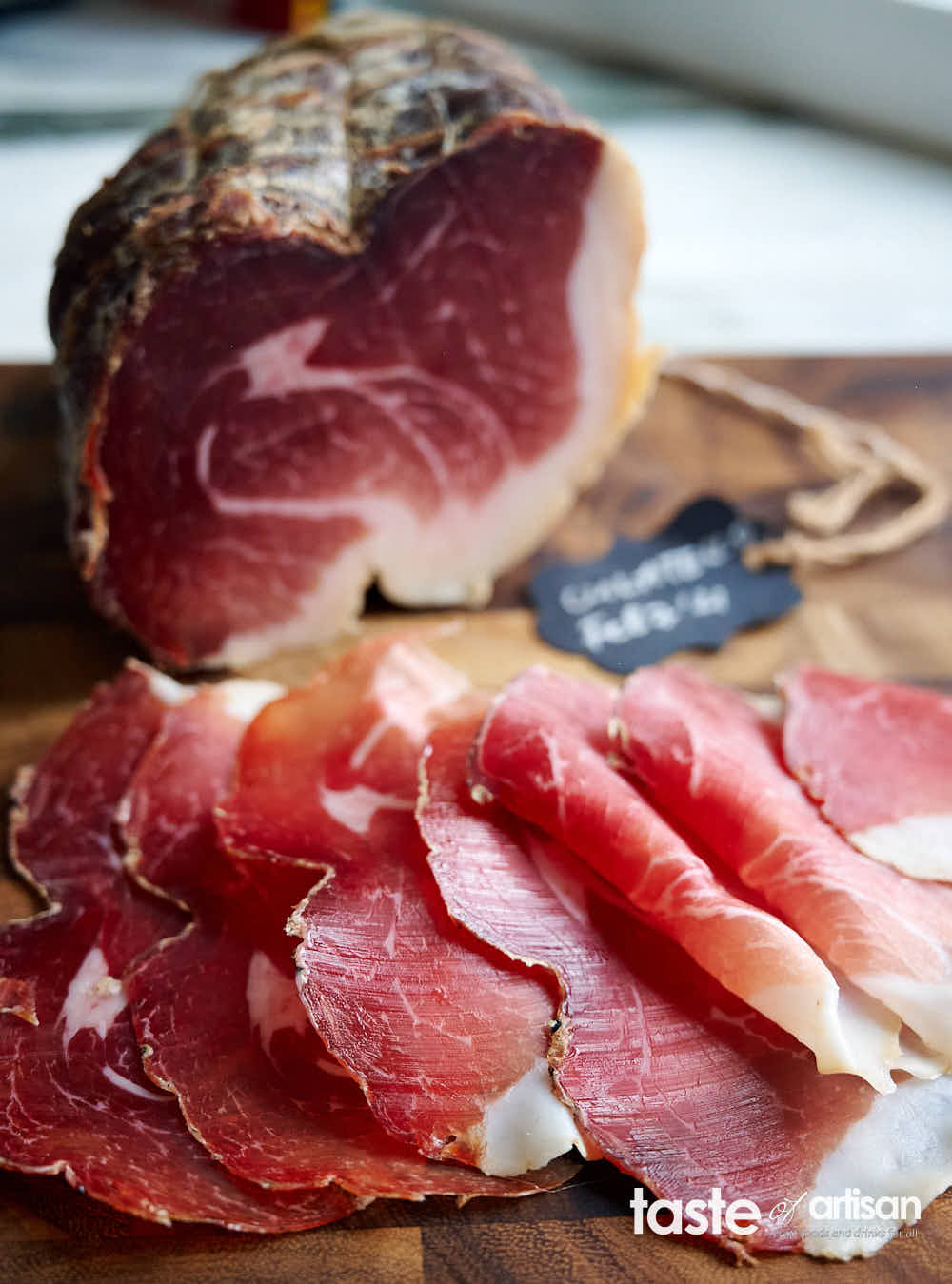
Speaking about flavor, I tried hard to describe it but just couldn't find the right words. There was a pleasant porky flavor like in your well-matured salami, but there was something else, something very special about this culatello. I asked my daughter to help me with that and she immediately said: 'Parmigiano Reggiano cheese". There! She nailed. It definitely had some of the notable characteristics of genuine cellar-aged Parmigiano Reggiano cheese: nuttiness, a whiff of lactic notes, and a touch of some spice. I used only black pepper and garlic but you can't tell them in the final product. It's all is just a balanced, gentle blend of appetite-inducing, mouth-watering flavors.
In the mouth, this meat is absolutely fantastic. It's hard to stop eating it. I really enjoyed the perfect saltiness and a mild tang. I often find things I could improve in most of my charcuterie pieces but this one is perfect, I would not change a thing. Well, there is only one thing I would change - next time I will try to target a lower weight loss. This one lost 41% of the original weight and was notably hard. Don't get me wrong, the taste is amazing, very intense and the color is rich. Better than what you'd find in prosciutto. But you absolutely need a good slicer to slice this one paper-thin to really enjoy it and I am just curious, how it would taste less dry. Typically, they target 30% to 35% weight loss for culatello. Can I even mature it for so long and have it not lose so much weight? Humidity would have to be pretty high and that comes with a host of issues.
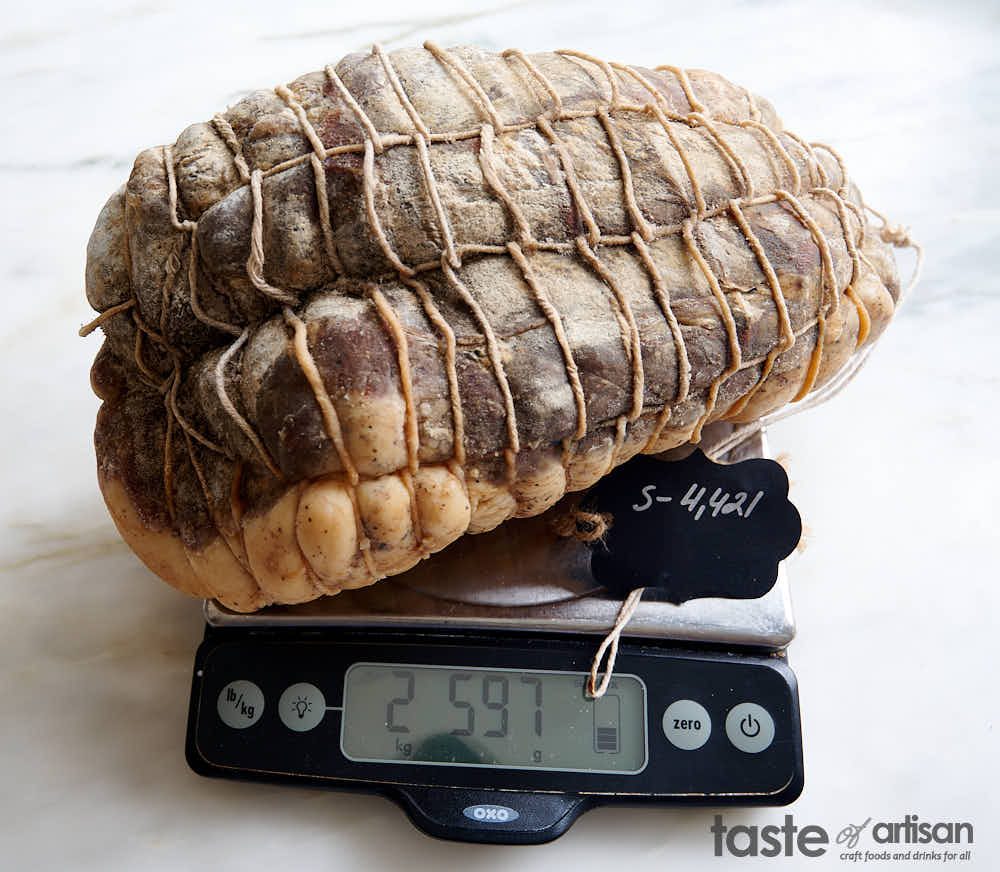
But wait a second!.. I forgot to follow the 'proper' culatello preparation etiquette - which is to soak the meat in wine for 2-3 days before consumption. Darn, I forgot to do it again as I was so eager to cut into it. Soaking in wine would definitely bring the hydration up... I will definitely do that next time. I will write a reminder on the tag!
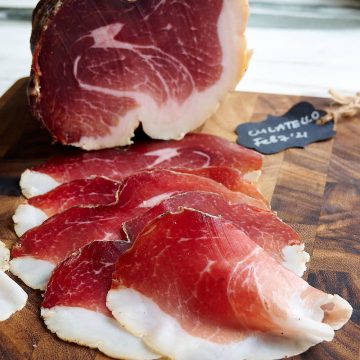
Homemade Culatello
Ingredients
- 1000 g pork leg culatello part - see video in the post
- 27.5 g Salt 2.75%; medium grain sea or kosher
- 2.5 g Cure #2 0.25%
- 2 g fresh garlic about 1/4 clove; liquefied in a mortar
- 1 g black pepper 0.1%
Instructions
- Debone and trim the ham into a uniform shape as shown in the instruction video in the post above.
- Weigh the meat in grams. Calculate how much of each ingredient you will need. If the meat weighs 1,650 grams, you will need 27.5 x 1.65 = 45.4 grams of salt, etc.
- Tie the meat with butchers twine as shown in the picture to give it a nice, rounded shape.
- Rub the meat with the liquefied garlic. Mix the salt, Cure #2, and black pepper together and apply evenly to the meat. Vacuum seal. Alternatively, you can place the meat and all the extra salt and pepper in a Ziploc bag and expel as much air as possible.
- Refrigerate for 14 days flipping the bag daily or so and givng it a quick massage.
- After 2 weeks in the fridge, remove the meat from the bag, scrape the surface with the dull side of a knife.
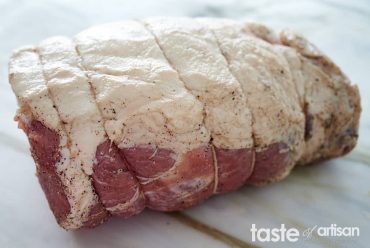
- Insert the meat into a pig bladder or a similar large natural casing (e.g. salted veil), prickle small holes all over with a sterilized needle, and truss with butchers twine.
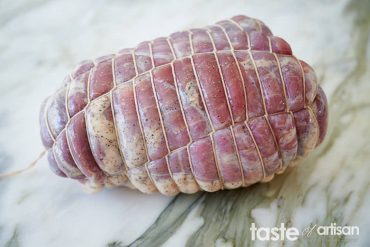
- Weigh the meat and write it down on a tag. Add the date and attach the tag to the meat.
- Hang and dry in the curing chamber for about 7 days as per the schedule below in the notes section.
- Mature in the curing chamber at 55F - 57F (13C - 14C) and 78% - 82% rH for 10-14 months.
- When the meat is ready, remove the twine and the casing, don't forget to remove the twin that was under the casing, slice paper-thin and enjoy.
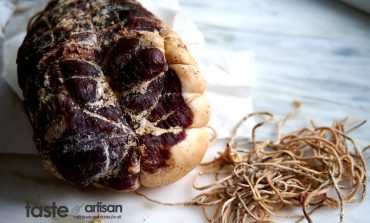
- If the meat is too dry, which most likely it will be, remove the outer twine and wash the meat under cold running water to remove mold, then let it dry. Next, soak it for two to three days in dry white or red wine. Remove the casing and the twine (the one under the casing) from the part you want to consume. Then slice it very thinly and enjoy.
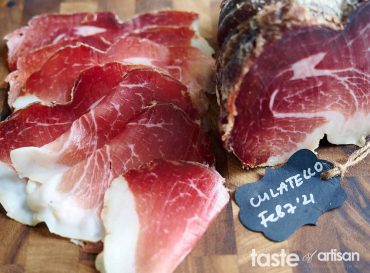
Notes
| Stage | Duration | Temp | RH |
|---|---|---|---|
| Fermentation | 14 hours | 75F (24C) | < 99 % |
| Drying | 17 hours | 73F (22C) | 75-85 % |
| Drying | 24 hours | 71F (19C) | 68-78 % |
| Drying | 24 hours | 68F (18C) | 65-75 % |
| Drying | 24 hours | 64F (17C) | 68-78 % |
| Drying | 24 hours | 61F (16C) | 72-82 % |
| Drying | 24 hours | 59F (15C) | 75-85 % |


Norbi says
Hi Victor!
I've done some of your great recipes before with success using collagen casings but now I wanted to make a new one using natural pig bladder as a casing for the first time. It has just arrived and smells so heavily ammonia (like an overriped red-washed rind cheese) that I choked and almost vomited... The bladder is also pinkish at some parts..
What do you think? Is it rotten and/or unsafe to use or is it always like this?
Thank you for your answer in advance 🙂
Victor @ Taste of Artisan says
LOL that, for sure, could be a challenge for a lot of people. I don't use pig bladder as it's not readily available so I use salted veil (pig stomach cavity lining), which is readily available and not too expensive. It doesn't smell bad, but beef bungs that I also use often can sometimes have a really strong smell. My wife can't stand it and while she can help me wash regular casings and veils, she won't touch those, LOL. What I do is I submerge them in water for a couple of hours then rinse thoroughly. Next, I take 2-3 lemons and a couple of limes, cut in half, squeeze the juice in a bowl with cold water, throw in the rinds too, and soak bungs in it overnight. Then next day rinse thoroughly. This removes a lot, if not most, of the smell.
Now, the pink stuff on pig bladder is normal, I think it's the part of vascular system which is explains red/pink color. Ammonia smell comes from urine, this is a pig's bladder, after all. Some butchers rinse those well, some don't. It's not bad, just needs a thorough rinsing and soaking in citric juice, it will help with the smell. I've used very smelly beef bungs, they still had some of that smell remaining but the time I stuffed meat in them, but none of that smell propagated into meat and there was none of it by the time the meat was fully dry and cured. Just my 2 cents on this.
Good luck!
Norbi says
Thanks for the quick answer! I don't trust the source of the bladder so I didn't use it, instead I sewed a couple of beef middles around the muscle with a sterilized needle. That did the job, but it took a lot of time and effort ... was a nightmare. I just wondered if it's possible to hang the meat on a hook directly without any casing next time... 🙂 Hmm
Victor @ Taste of Artisan says
Sorry to hear about your misfortune with the pig bladder. Sowing sounds like a lot of work and may be prone to ripping... I'd just layer them with about a 1" overlap, then truss. But if you want to do it without the casings, it's certainly possible. I make speck like that. The problem will be the mold developing in the crevices and drying out. Speck is always smoked, and I think a good reason for doing that is to keep mold away as smoke is a preservative. I'd smoke the meat before maturing. Casing also helps regulate water removal from the surface, otherwise the meat dries out relatively fast and hardens. I see that with speck. It's a different product from culatello, different texture. I like it a lot too. I'd make speck instead if you want it without the casing, just follow that process and it will be fine. Same meat cut.
Alvar says
Nice color, indeed.
Must have been delicious.
I tried mine with the microporous foil and a net and came out ok -I think-.
It just was on the verge of starting developing the magic nutty flavour,
but seriously, I couldn't wait any longer 😀
I'll make more, further on.
Victor @ Taste of Artisan says
It was. I will be ordering more pork this fall and will definitely be making more culatello. Waiting is hard, I know. That's why I like curing a bunch of cuts, small and large, so I can start enjoying some of them early and not be tempted to cut into large pieces too soon. I don't have experience with anything resembling microporous foil, but I have tried collagen sheets and artificial fibrous casings. IMHO, nothing compares with natural casings. Pig bladders are impossible to find here where I live, at least I couldn't, but salted veil is easy to get so I stick with it. I once ran out and needed a large sheet for something, so I used a beef bung instead. It was too small to fit in the large piece of meat that I wanted to cure so I took two, cut them on one side and used like I would salted veil. It worked great.
JPT says
The cuatello and fiocco were special order from a local butcher (Salt Lake City, UT) and very expensive. Very simple salt and pepper cure. After 12 months in the curing chamber, the meat was fantastic. I cut into chunks and vacuum packed them. Unfortunately, I did not refrigerate them and the taste/consistency deteriorated. Consume quickly, or vacuum and refrigerate.
Victor @ Taste of Artisan says
I am not surprised it was expensive. Most butchers here, I would imagine, wouldn't even know what those are and how to prepare them simply because they don't have much/any experience with these cuts. DIY isn't too difficult though.
I have a storage question for you - when you say you didn't refrigerate, did you vac seal and store in the curing chamber or at a room temp?
Steve Denvir says
I know, I know. But a general charcuterie question. The best way to store salumi? There’s just my wife and me, so even with guests, it takes us a while to get through a lonzina or capicollo. Have you got any general principles you can share?
Thanks in advance
Victor @ Taste of Artisan says
Steve, it's right in the post under 'Storing Culatello'. Works for me very well.
Steve Denvir says
Oh great, another rabbit hole you’re leading me down :-).
Sounds absolutely fabulous. I think I’m gonna have to have a chat with my butcher.
Steve
Victor @ Taste of Artisan says
So worth it, Steve. So worth it. 😉